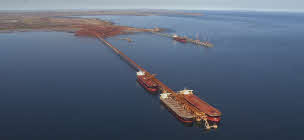Blockchain set to bolster steel value chain amidst Asia's strong growth
Strong Asian performance is set to drive the growth of the steel, says Mike Zhang, Managing Director and Global Head, Metals and Mining industry group, DBS, and blockchain has a key role to play in these developments. Here are his insights.

Asia is a major producer and consumer of steel, the most widely used raw material in modern industrialisation. According to the latest issue of "World Steel in Figures 2021" published by the World Steel Association, Asia produced 73.9% of the world's 1.88 billion tonnes of crude steel in 2020. In the same year, global consumption of finished steel reached 1.77 billion tonnes, 73.3% of which went to Asia.
When the pandemic saw major economies worldwide liberalising monetary policies and injecting abundant liquidity, economists naturally raised inflation forecasts. At the same time, an optimistic view of Asia's post-pandemic economies also heralded a surge in demand for steel, a pro-cyclical commodity, which drove up steel prices and eventually pushed ore prices to record highs. With soaring iron ore prices and most iron ore supply being monopolised by major mines, there has been a spike in market liquidity and speculative capital in iron ore futures.
China's policy changes will impact global steel production volume
While Asia's post-pandemic economic recovery and increased investment in infrastructure will spur steel demand, China - the world's largest steel producer accounting for more than half of global steel production - will cap its production capacity. This will be the biggest factor affecting the global steel industry.
The policy to reduce crude steel production is mainly driven by the Chinese government'ÂÂs environmental protection and carbon reduction commitments. According to the policy requirements, China's crude steel output in 2021 should not exceed that of 2020, which was 1,053 million tonnes. With 473 million tonnes of steel already produced in the first five months of 2021, the expectation is that production in the second half of 2021 will need to be reduced by at least 50 million tonnes.
While China's policy of curbing its steel production will protect steel mills and sustain steel prices to ensure a reasonable level of profit for steel companies, it will also lower the demand for iron ore and create downward pressure on iron ore prices. China is also striving to obtain and develop iron ore resources in Guinea in Africa, Australia, and Brazil. Particularly in Brazil, iron ore mining has been scaled back due to ESG requirements and, more recently, recurring outbreaks of COVID-19. However, in the medium to long term, iron ore prices are expected to fall as supply and demand shift, returning to around USD 100 per tonne come 2023.
Growth drivers and investments will be centred in South and Southeast Asia
Despite a reduction in steel production, global demand for steel remains strong amidst the expected rebound in global infrastructure investments. In Southeast Asia specifically, optimism about economic recovery and GDP growth has been the key driver for investment in infrastructure.
With policies controlling crude steel production in China, investment will shift to South and Southeast Asia. ArcelorMittal is returning to the Indian market; Formosa Plastics is directing a great of attention to Vietnam, and Chinese steel mills are investing in new stainless steel and coke projects in Indonesia. India also has plans to develop 300 million tonnes of steel production capacity by 2030 - with its abundance of iron ore resources; the country has a marked advantage over any other nation in the race.
These developments point towards a vigorous steel value chain and increased local consumption stimulated by new investments in Asia, particularly Southeast Asia. China is supercharging its post-pandemic economy, and signs of recovery bode well for Southeast Asian nations. Steel consumption in the 10 ASEAN countries in 2021 is expected to exceed six per cent, reaching approximately 75 million tonnes, and consumption is set to rise year-on-year, further pushing the demand for steel.
Blockchain-based transactions will propel the steel industry to its next level of growth
The pandemic has hyper-accelerated digital adoption, both in our daily lives and in the development of new transaction processes. With increased trade activities in South and Southeast Asia, blockchain has been identified as the key technology to facilitate the safe and secure movement of goods among upstream, midstream, and downstream players.
From mining to finished products, through processes from smelting to processing to transportation, blockchain can enable the steel industry to become more transparent and traceable - reducing costs and paperwork and improving the movement of goods. With blockchain, players in the steel industry are better equipped to conduct transactions efficiently and securely, even in the face of surging trade volumes.
As the world's best digital bank, DBS uses the power of blockchain to help our clients speed up transactions, reduce costs, and mitigate risks. Our capabilities, coupled with the fact that we are headquartered in Singapore, with preferential free trade policies, puts us in a favourable spot for the business.
DBS is also the only Asian bank with a pure-play Metals and Mining industry coverage team. The bank was the first in Asia to be issued membership in the London Metal Exchange, thus expanding our suite of hedging and financial solutions.

